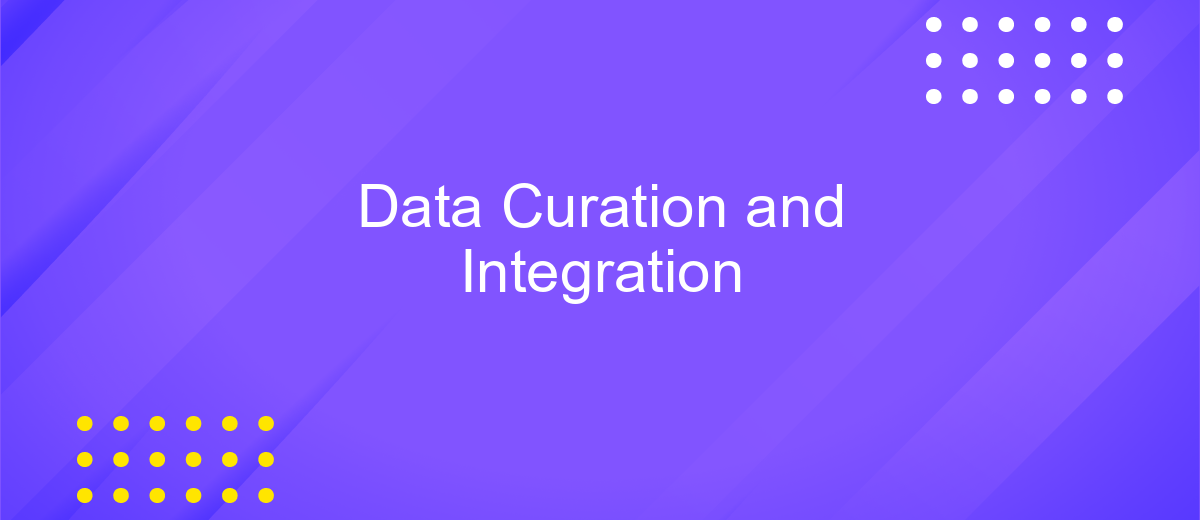Data Curation and Integration
Data curation and integration are pivotal processes in the age of big data, enabling organizations to harness the full potential of their information assets. By systematically organizing, managing, and merging data from diverse sources, businesses can ensure data quality, consistency, and accessibility. This article explores the methodologies, challenges, and benefits of effective data curation and integration, highlighting their role in driving informed decision-making and innovation.
Introduction to Data Curation and Integration
Data curation and integration are essential processes in the modern data-driven landscape, ensuring that data is accurate, accessible, and useful for decision-making. As organizations generate vast amounts of data, the challenge is to manage and integrate this data effectively to derive meaningful insights. Data curation involves the organization, annotation, and preservation of data, while integration focuses on combining data from various sources to provide a unified view. Together, they enhance the value and usability of data.
- Data curation ensures data quality and consistency through meticulous organization and cleaning.
- Integration involves merging data from disparate sources, enabling comprehensive analysis.
- Both processes support informed decision-making by providing reliable and holistic data insights.
The importance of data curation and integration cannot be overstated in an era where data is a critical asset. By implementing robust curation and integration strategies, organizations can unlock the full potential of their data assets, driving innovation and competitive advantage. As data continues to grow in volume and complexity, these processes will remain pivotal in transforming raw data into actionable intelligence.
Key Principles and Best Practices

Effective data curation and integration require a clear understanding of data sources and the establishment of robust data governance frameworks. Prioritizing data quality is essential, involving regular validation and cleaning processes to maintain accuracy and reliability. Ensuring data consistency across platforms is crucial, which can be achieved through standardized data formats and metadata documentation. Additionally, collaboration among stakeholders is vital to align objectives and foster transparency in data management practices.
Utilizing integration tools like ApiX-Drive can streamline the process of connecting disparate data sources, automating data workflows, and reducing manual intervention. Such platforms facilitate seamless data transfer, ensuring timely and efficient data availability for analysis. Best practices also include implementing security measures to protect sensitive information and compliance with relevant regulations. Continuous monitoring and feedback mechanisms are necessary to adapt to evolving data needs and improve integration strategies over time.
Data Curation and Integration Techniques

Data curation and integration are pivotal processes in managing and utilizing data effectively. Curation involves organizing and maintaining data to ensure its quality and accessibility, while integration focuses on combining data from different sources to provide a unified view. Together, these techniques are essential for maximizing the value of data, enabling more informed decision-making and enhancing data-driven insights.
- Data Cleaning: This involves detecting and correcting errors or inconsistencies in data to improve its quality.
- Data Transformation: Converting data from one format or structure to another to make it compatible with other datasets.
- Schema Matching: Identifying correspondences between data models to facilitate integration.
- Data Deduplication: Removing duplicate data entries to ensure accuracy and reduce redundancy.
- Metadata Management: Utilizing metadata to provide context and improve data discoverability and integration.
By employing these techniques, organizations can enhance the reliability and usability of their data. Effective data curation and integration strategies not only streamline data workflows but also empower businesses to leverage their data assets more strategically, fostering innovation and competitive advantage in the data-driven economy.
Challenges and Solutions in Data Curation and Integration

Data curation and integration present significant challenges in today's data-driven world. One major issue is the heterogeneity of data sources, which often leads to inconsistencies and redundancies. Diverse formats, structures, and semantics make it difficult to ensure data quality and coherence. Additionally, data privacy and security concerns complicate the integration process, as sensitive information must be protected across various platforms.
Another challenge is the scalability of data integration processes. As data volumes grow exponentially, traditional methods become inefficient, requiring innovative solutions to manage large datasets effectively. Furthermore, the lack of standardized protocols for data exchange and integration can hinder seamless collaboration between different organizations and systems.
- Implementing advanced data transformation techniques to harmonize diverse data formats.
- Utilizing machine learning algorithms to automate data cleaning and integration tasks.
- Adopting robust data governance frameworks to ensure compliance and security.
Addressing these challenges requires a multifaceted approach. Organizations should invest in cutting-edge technologies and foster collaboration between data scientists, IT professionals, and domain experts. By doing so, they can enhance data quality, streamline integration processes, and unlock the full potential of their data assets.
- Automate the work of an online store or landing
- Empower through integration
- Don't spend money on programmers and integrators
- Save time by automating routine tasks
Future Trends in Data Curation and Integration
As the volume and complexity of data continue to grow, future trends in data curation and integration are set to focus on automation and artificial intelligence. Machine learning algorithms will increasingly be employed to automate the processes of data cleaning, transformation, and integration, reducing the manual effort required and enhancing accuracy. This shift will allow organizations to handle larger datasets with more efficiency, providing real-time insights and facilitating faster decision-making.
Moreover, the rise of no-code and low-code platforms is expected to democratize data integration. Services like ApiX-Drive are already paving the way by enabling users to set up integrations without extensive technical expertise. These platforms will become more sophisticated, offering seamless connectivity between disparate data sources. Additionally, the emphasis on data governance and privacy will lead to the development of more robust frameworks to ensure compliance and security in data handling. As these trends evolve, they will redefine how businesses leverage their data assets for strategic advantage.
FAQ
What is data curation and why is it important?
What are the main challenges in data integration?
How can I automate data integration processes?
What role does data governance play in data curation and integration?
How can I ensure data quality during integration?
Apix-Drive will help optimize business processes, save you from a lot of routine tasks and unnecessary costs for automation, attracting additional specialists. Try setting up a free test connection with ApiX-Drive and see for yourself. Now you have to think about where to invest the freed time and money!


